
It was a positive week for US and local stocks with the S&P500 up 1.28%, while we added 1.72% with the S&P/ASX 200. Friday brought a bit of negativity but there were some pluses that could be added to the improving inflation story.
In a nutshell, the positive on Wall Street was all about strong earnings from JPMorgan Chase, whose shares shot up 7.2%! However, just when they should’ve been popping champagne corks on the New York Stock Exchange, along came the March retails sales, which dropped 1% instead of the predicted 0.5%.
“The cumulative effect of historically high inflation, rising interest rates, and reduced access to credit is already taking a toll on consumers’ ability and willingness to spend,” said Lydia Boussour, senior economist at EY Parthenon. “The consumer engine lost significant momentum as the (first) quarter progressed, setting the stage for weak consumption growth in the second quarter.
So we have a market battle about whether stocks will benefit from falling inflation (which was the big takeout from the past week) or a looming recession.
You can never be complacent about inflation. Central bank bosses like the Fed’s Jerome Powell and our Reserve Bank supremo Dr Phil Lowe know this but it was a very good week for killing US inflation. The big question is whether the inflation dragon is running out of fire. On Thursday, Wall Street bought stocks as if the big players were saying ‘yes’! with a capital Y!
The Dow was up 1.14% while the Nasdaq fell just short of a 2% jump. So, what was it about US inflation that was behind this optimism.
First, the CPI came in lower than expected. On an annual basis, it was up only 5%, which was well below expectations. This is how The Financial Times viewed the result: “That marks a significant deceleration compared with the 6 per cent rate recorded in February and is the lowest reading since May 2021. On a monthly basis, consumer prices increased just 0.1 per cent, shy of economists’ forecasts”.
Then on Thursday, the US producer price inflation reading slowed to just 2.7% year-on-year. This also points to a further fall in CPI inflation.
This was AMP’s Shane Oliver’s take on the figure: “In fact, both CPI and PPI look to be falling just as fast as they went up! Of course, it never feels that way day to day and week to week, given all the noise around inflation lately”.
Shane Oliver shouldn’t be surprised, given his Inflation Pipeline Indicator that I’ve been showing you for months to prove that inflation would eventually fall. This will be a prelude to a rebound in stocks, provided the US doesn’t end up in a deep recession.
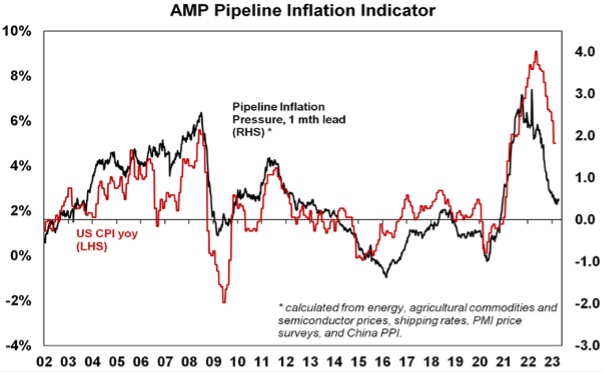
That Thursday rise in stocks suggests that those sweating on lower inflation to buy stocks outnumbered those selling, because the smaller price rise was maybe pointing to a not-so-mild recession being on the horizon. Until this week, most economists were in the “mild recession” camp but on Wednesday recession worries escalated and stocks fell.
That helped dip buyers, who think stocks have upside as we get deeper into 2023 and then into 2024.
My feeling is that the battle between those cheering that inflation is falling and those fearing recession will influence what the stock market does in coming weeks and months, until victory over inflation is declared by the Fed and the recession threat doesn’t look too serious.
If and when we get that, stocks will surge. However, there are a few ‘ifs’ and ‘buts’ in all that, though that shouldn’t surprise you, if you’ve been a long-term investor. That said, the trend is your friend and the Nasdaq Composite has been our friend since October 2022, when it comes to what the consensus is predicting is more likely to happen.
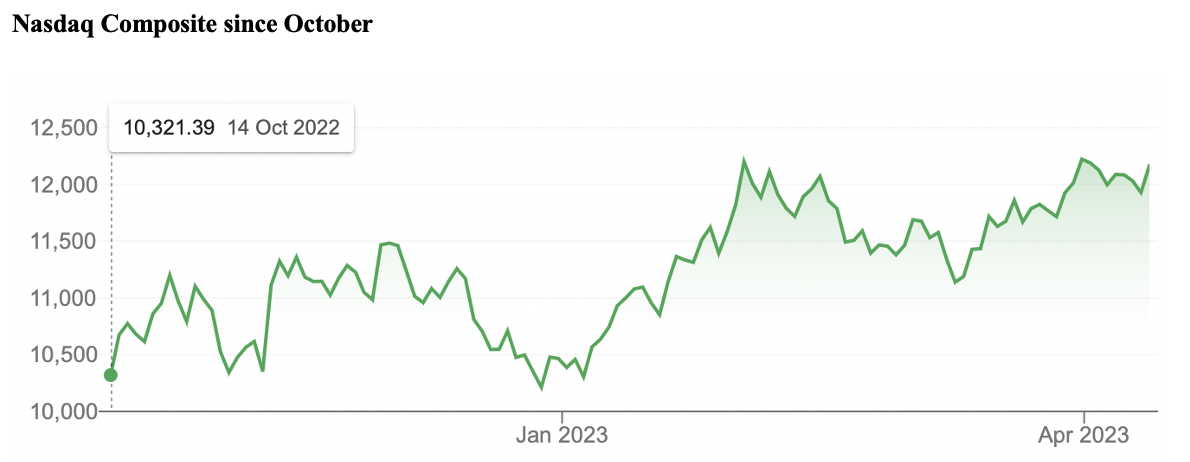
That’s a 17.87% rise since October 14 on the chart above!
CNN’s Nicole Goodkind says experts think US inflation has hit an inflection point, and that explains why the Nasdaq was up close to 2% on Thursday. “After more than a year of soaring prices monopolizing the attention of Wall Street, Main Street, economists, and journalists, the tide may be turning,” she wrote. “According to some experts, inflation rates have reached an inflection point and painful interest rate hikes could soon ease.”
“Once inflation gets down below 5%, it disappears from the headlines,” Johns Hopkins economist and central bank scholar Laurence Ball told Before the Bell last month. “People go back to worrying about budget deficits or climate change or other public issues there are.”
The 5% idea dates back at least to the 1980s when former Federal Reserve vice chairman Stanley Fischer identified the threshold number as the point where inflation dropped way down the rankings of the nation’s problems.
Chief investment strategist at CFRA Research Sam Stovall liked what he saw on the US inflation front. “The movement in the market today clearly is reflecting the continued decline in inflationary pressures — and the belief, therefore, that the Fed will more likely stop with one more rate increase rather than two,” he told CNBC. “Investors are becoming optimistic that times will improve.”
All this is good news for stock market optimists. Now we have to hope the Fed stops rate rises ASAP to ensure it doesn’t create a recession challenge for the economy and stocks.
As the AFR’s Cecile Lefort reported: “Out of the top 10 performers on the index, gold and lithium producers took no less than seven spots. Silver Lake Resources climbed 6 per cent to $1.33, Allkem jumped 5.4% to $11.64, Pilbara Minerals advanced 5% to $3.75. Northern Star rallied 4.35% to $14.40, Regis Resources added 4.3% to $2.43 and West African Resources rose 3.8% to $1.09.”
Here are the big winners and losers of the week
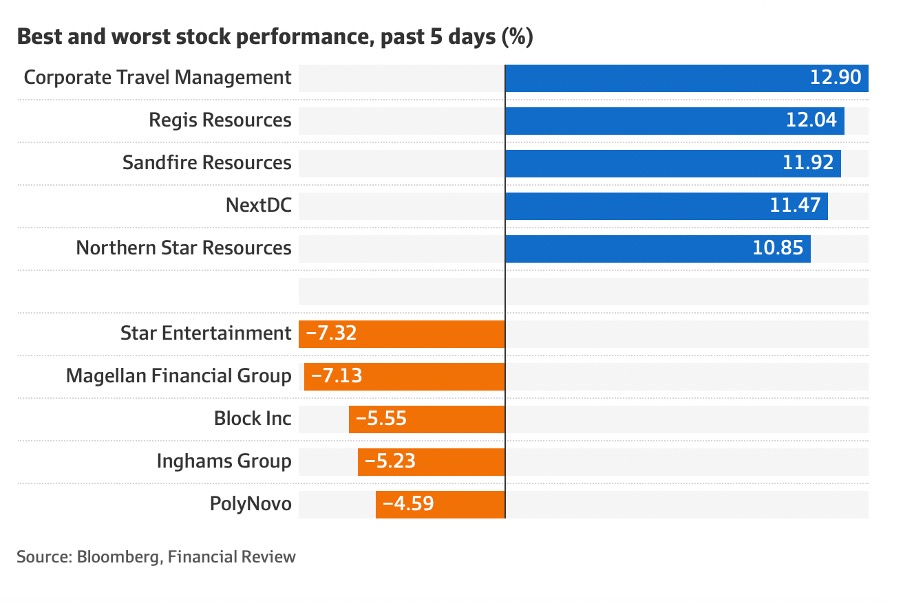
At long last the market has started to see merit in a company we’ve always liked — Next DC — which put on 11.47% over the past five days. Corporate Travel Management was a star performer as reports give travel in the year ahead a solid thumbs up, despite rising interest rates now hitting discretionary spending.
What I liked
- Local consumer confidence (as measured by WBC/Melbourne Institute) rose by 9.4% in April 2023 to 85.8 points, as the RBA paused its rate hiking cycle.
- Business confidence increased by 3 points to minus 1. The level remains in the negative and below the long-term average, but a rise helps me think we can dodge a recession or serious slowdown. Business conditions are holding up pretty well, despite 10 rate rises.
- US inflation news — these were rippers! The CPI was at 5% and the Producer Price Index was at 2.7%.
- US yield curves are falling, which says the Fed will soon stop rate rises.
What I didn’t like
- The strong March jobs data of 53,000 new jobs and unemployment at 3.5%, again, adds to the risk of a wages breakout and increases the risk of another RBA rate hike in May.
- US core inflation at 5.6%. This is coming down but I’d like a faster fall.
- US yields are falling, which is good for predicting a halt to rate rises but they also suggest a recession isn’t far away!
- Those US retail numbers overnight.
Keep watching the numbers
Data remains the main game in town for stocks and given what we’ve seen in the past three weeks, I remain positive that 2023, will be a good one for stocks but there will be some heart-pumping moments. US company reporting will have the heart racing in coming weeks, so watch this space!
Big stories of the week
- Dr Phil is desperately seeking the Goldilocks economy
- RBA confesses it did a ‘crap’ job but it could be OK!
- Unreliable forecaster the IMF says Aussie outlook is dismal
- Tax cut to go – is Dr Jim getting the timing wrong?
From the Report
- Two ETFs for exposure to this copper megatrend
- “HOT” stock – Commonwealth Bank (CBA)
- Questions of the Week
- petBoom Doom Zoom!
- No Switzer TV because of the Easter public holiday.
Top stocks this week
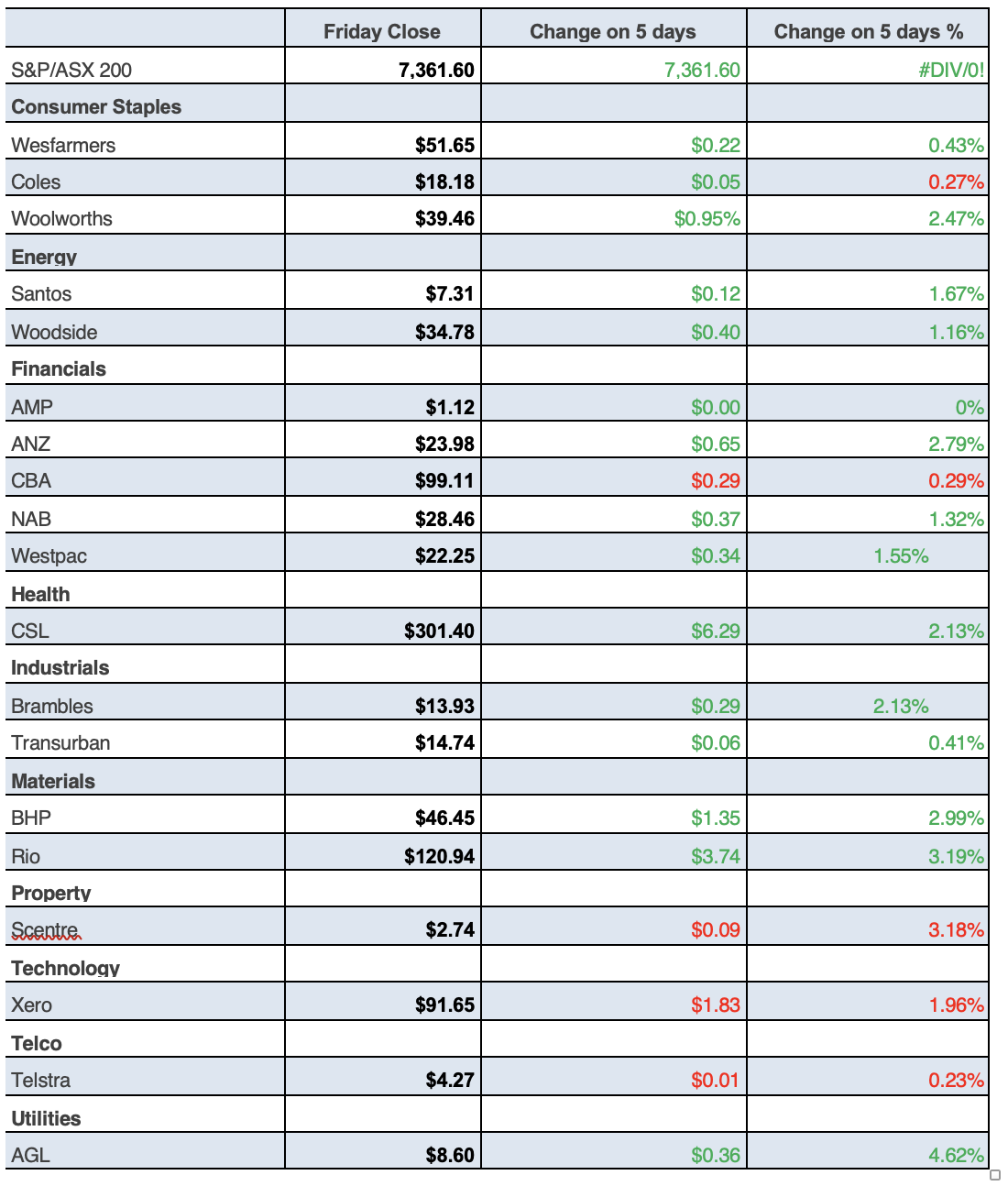
The week ahead
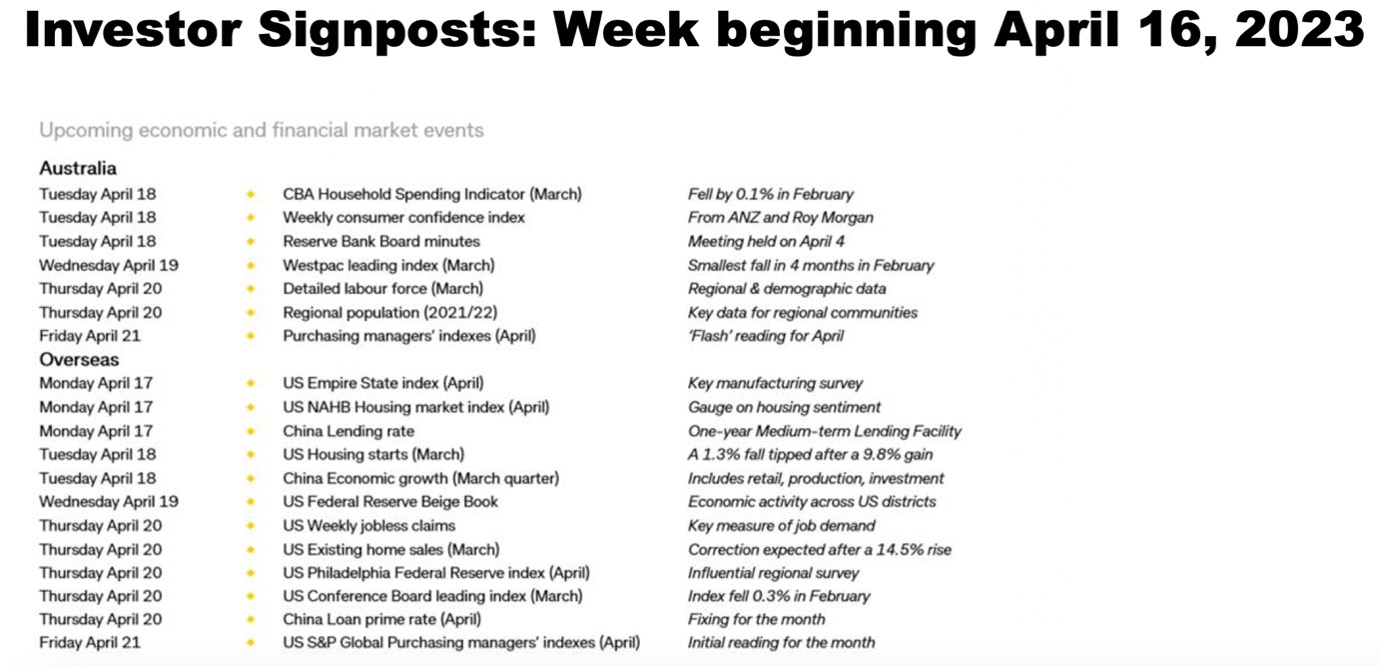
Quote of the week
On a day when CBA’s chief economist tipped the RBA might be cutting interest rates later this year, Treasurer Jim Chalmers said this to ABC radio: ““We do expect, or the Treasury does expect our own economy to slow considerably later this year because of that combination of a slowing global economy and the impact of higher interest rates here at home as well.” (SMH.com.au)
Chart of the week
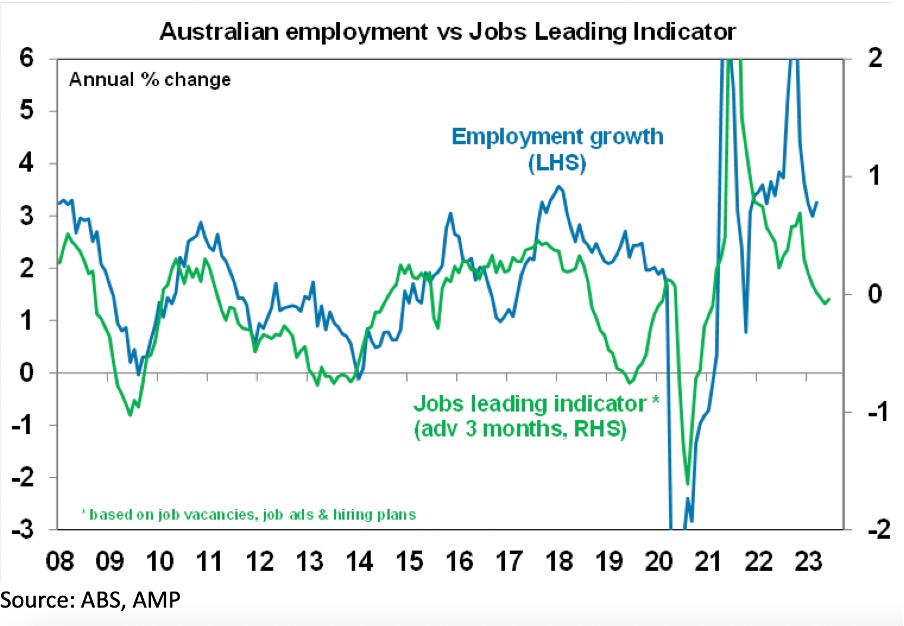
Unemployment remains stubbornly low, which could be bad for beating inflation and stopping interest rate rises. However, wage rises have not been excessive in Australia, so we might get a Goldilocks outcome of cooler/lower inflation and a warmer/stronger economy than are expected. This will be good for company profits and, importantly, share prices!
The RBA will be looking at wage data very closely.
Important: This content has been prepared without taking account of the objectives, financial situation or needs of any particular individual. It does not constitute formal advice. Consider the appropriateness of the information in regards to your circumstances.

